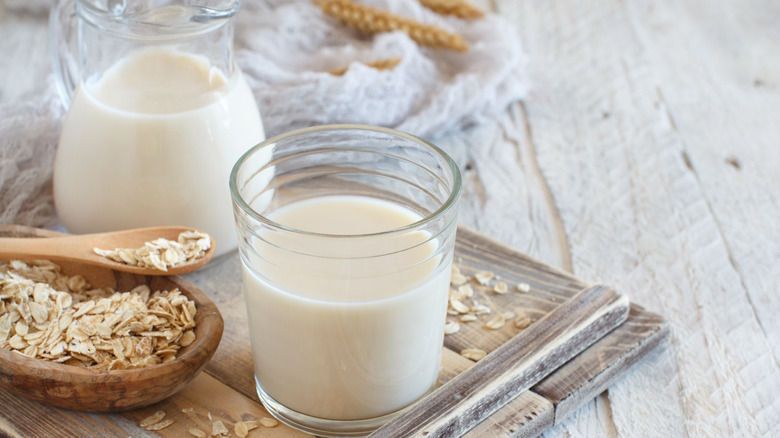How To Make Oat Milk Without The Slimy Texture
While you can buy oat milk in cartons at the grocery store, there are quite a few benefits of making your own at home. It can be less expensive, you can make it in smaller quantities, and you can adjust the amount of sweetness and flavorings that go into the beverage, which is particularly important when you want to use it in other recipes like oat milk honey lattes. When you first begin to make your own oat milk, however, there can be a bit of a learning curve. In particular, you might find that your homemade oat milk has a little bit of a "slimy" texture when you sip it. Fortunately, there are a few easy adjustments you can make to combat that unpleasant texture and leave you with a delicious drink.
The process of making the milk is as simple as blending together oats and water, but one of the biggest contributing factors to creating that slimy texture in oat milk is heat. To eliminate it, make sure to keep every component of the oat milk cool during the blending process. In fact, you should never blend hot liquids, so to keep the oats cold make sure to chill your water before adding it to the mix.
Ice cubes keep thing cool
While you can simply chill your water in the fridge before blending it with your oats for oat milk, ice can also be useful in preventing your oat milk mixture from heating up and becoming slimy. Prior to blending your ingredients, add some ice to your water to make it extra cold, then when you're ready to blend simply remove the ice cubes and proceed as normal.
If you really want to ensure your oat milk stays super chilled though, you can even keep some ice in, but make sure you're adjusting your recipe accordingly to avoid a watered-down mess. Omit one cup of water from the recipe and replace it with the same quantity of ice. As the blender breaks them down, the ice cubes will keep everything extra cool.
In addition to cold water to keep your mixture cool, be sure not to blend the oat milk for too long. As the blender cuts through the oats, the friction from the sharp blades could actually cause them to heat up. Generally, you'll only need to blend the mix for 30 to 45 seconds to get it to the right consistency.
Straining is an important step
Once your oat milk has been blended, you'll need to strain it to make sure the beverage is smooth. Even when your mixture is kept cool, oats contain a fiber called beta glucan that can contribute to that slimy texture when mixed with water. While you can purchase bags specifically designed for straining homemade plant-based milks, the same can be attained by simply using a finely woven cloth. Dish towels or clean T-shirts can work for this purpose.
Using the right amount of pressure is important for straining, too. You'll want to work gently as you strain the oat milk because extra pressure could cause more of the oat fiber to escape through the towel. Instead of squeezing the milk through, allow it to slowly drip through the towel and into a clean container. If you really want to make sure all the fiber is out, you can repeat the process and strain the liquid a second time.
So the next time you blend up some homemade oat milk, remember to keep your water cold, your blending short, and your straining gentle for the creamiest oat milk possible.


